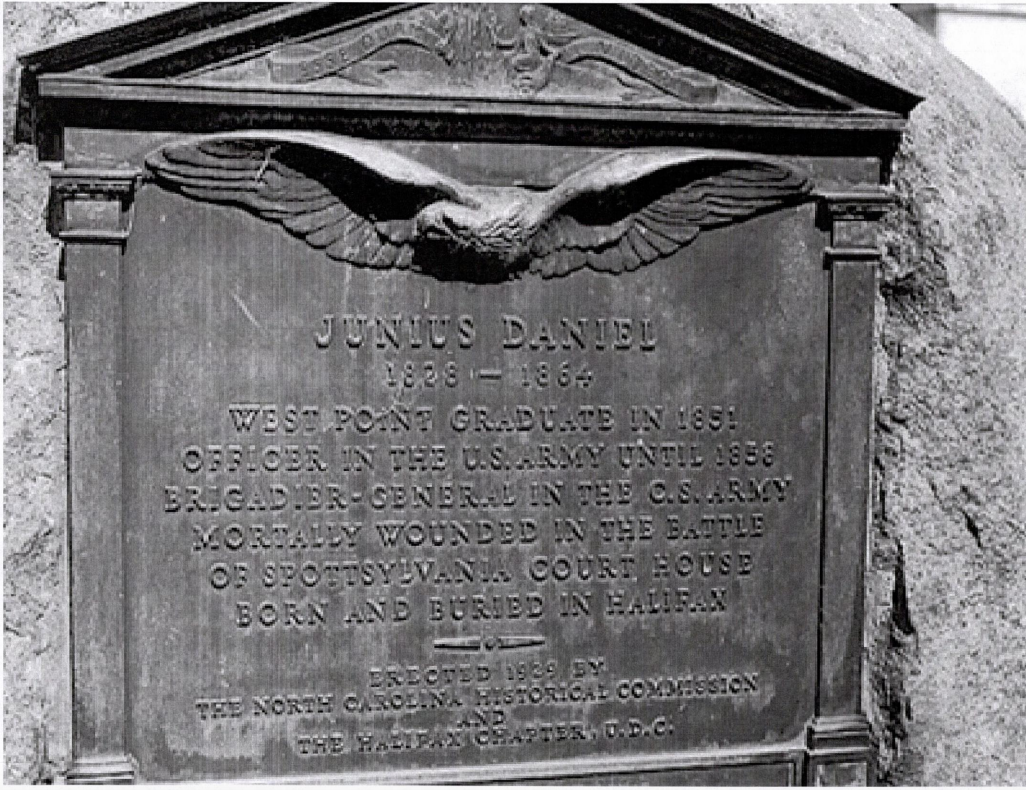Moving a memorial honoring a confederate war general located on the grounds of the Historic Courthouse on King Street in Halifax will not be a process which can be immediately accomplished, County Attorney Glynn Rollins told commissioners Monday.
More research will be required in trying to determine ownership of the memorial, which recognizes confederate Army Brigadier General Junius Daniel, a marker which was placed on the courthouse square in 1929.
The request to remove the tablet was made by Rodney D. Pierce, a Roanoke Rapids resident, and an eighth-grade social studies teacher in the Nash-Rocky Mount school district.
Pierce’s contention is Daniel was “a person who armed himself to defend the right of another person to kidnap men, women and children and sell them to the highest bidder, who would enslave that person to do with them as they pleased.”
(Pierce’s entire remarks to the board may be found at this link)
Pierce said Daniel was born into a wealthy, slaveholding family, and was actively involved in the business of acquiring, managing and bartering human chattel, and was well aware of its benefits. His grandfather, Willie Daniel, enslaved 13 Africans according to the 1800 United States census. Reviewing subsequent censuses, Daniel’s father, John Reeves Jones Daniel, enslaved six in 1830, 15 in 1840 while he served as North Carolina’s attorney general, 38 in 1850 while serving as a United States congressman from North Carolina, and 51 in 1860 while working as a farmer.
Not only was there and still remains the tablet honoring Daniel on the courthouse lawn, but at the time it was erected there was a segregated outside water fountain. “I can only imagine how a Black person in the past must have felt walking up to this courthouse looking for justice, while a tablet honoring a Confederate general who came from a slaveholding family rested on the front lawn along with a sign that reminded them that though you’re no longer enslaved, you’re still a second-class citizen. While that sign is gone, the tablet remains in the front of a building where now, not only do our elected county officials meet, but where our county manager’s office, county legal office, county finance office and Board of Elections are housed.”
Said Pierce: “Make no mistake. Junius Daniel gave his life to preserve two things: The ideology of White supremacy, and the continued enslavement of Black people.”
In the gallery: A photo of Daniel, the segregated fountain, the tablet, a clipping of the event in 1929, and Daniel family slave records
-
 Click to open image!
Click to open image!
Click to open image!
Click to open image!
-
 Click to open image!
Click to open image!
Click to open image!
Click to open image!
-
 Click to open image!
Click to open image!
Click to open image!
Click to open image!
-
 Click to open image!
Click to open image!
Click to open image!
Click to open image!
-
 Click to open image!
Click to open image!
Click to open image!
Click to open image!
https://www.rrspin.com/news/3068-research-will-continue-on-moving-tablet-honoring-csa-general.html#sigProId5c49713610
Rollins told the board after Pierce’s request, “If you come to the decision you want to have this memorial moved to another location the first question you’re going to have to answer is who owns it. So far as I’ve been told right now it appears that it is owned by the United Daughters of the Confederacy. We no longer have a Halifax Chapter so it appears the ownership would revert to the state chapter of the UDC.”
Rollins said he has had conversations with the president of the Roanoke Rapids chapter. “They located minutes of the Halifax chapter. They’re reviewing this now to see whether the UDC chapter ever conveyed the memorial to the county. I find no record that the county’s ever taken ownership of that memorial.”
The attorney has found a record of the commissioners in 1929 allowing the memorial to be placed on the front lawn of the courthouse. “I don’t find any record ownership has ever been transferred to the county by the UDC or any other entity.”
Rollins has found a record of the tablet at the North Carolina Historical Commission and sent a letter to its chair asking whether the state has any claim to it. “The reason ownership is important to this is if that tablet is owned by the state you have very little authority to move it. Warren County moved their monument a few weeks ago and their county attorney said it was to preserve it to save it from vandalism or damage. If it is your monument that is one of the reasons you can move it. You can move it temporarily for construction reasons.”
Rollins said most of the monuments which have been removed across the state are usually those which the UDC or a private entity has an agreement with the county. “If the UDC still owns the memorial, I think they do, in this case the statute (NC GS 100-2.1)
would not apply. There’s no restrictions as long as you have a written agreement with the UDC about removal of memorials. It’s very important to determine who owns it.”
Pierce told Rollins he has emailed the national UDC. “I was prepared to work with the UDC to come to an agreement.”
Pierce said he has no desire to see the tablet destroyed. “As a descendant of a slave people I could understand wanting to destroy it, however, as a historian and a history teacher I don’t want it destroyed. I think it should be in a more appropriate location such as Historic Halifax.”
Rollins said Daniel is buried in the cemetery surrounded by Historic Halifax but the cemetery itself is actually owned by the town of Weldon. “There are options here but it depends on what you want to happen, what you want the next step to be.”
Commissioner Carolyn Johnson said, “It would be a good idea to place it somewhere else. I also think it would provide for our students a teaching moment and provide for a history of our children things that they don’t know. My position is that we remove it.”
Commissioner Marcelle Smith, who has discussed the matter with Pierce previously, said, “I echo what Ms. Johnson has said. I also agree in honoring and respecting those that have served for us. However, as an African-American, it does hit home what is going on. I thank attorney Rollins for the legwork he has begun. I for one would ask that he continue to search and find out.”
Rollins said if the memorial is owned by a private entity such as the UDC and the county wants to remove it, “That’s a good thing, assuming you can come to an agreement with the UDC, otherwise you’re very limited. You cannot move it to a cemetery or museum if it wasn’t in a cemetery or museum originally.
“If you really want to have a clear way to reach a consensus about moving it the hope is the UDC is still the owner because they could come to an agreement with the county about doing what Ms. Johnson has already voiced and that is moving it to a location that’s a more appropriate location. That can’t happen unless the UDC is still the owner.”
Commissioner Rives Manning said, “I’ve been involved in history a long time. The historic site, we have tried to do some things with the confederacy down there. They don’t want it. Their time frame is colonial so I think you definitely must have the authority or approval of the historic site to take it. You’ve got a lot of groundwork. It can’t be done today.”
Commissioner Patrick Qualls said, “I think we’re going down the exact right path by doing it by the next meeting. You’ve got to do the research, you’ve got to get in touch with the state.”
Rollins reiterated the primary things which have to be done now are to confirm the UDC is still the owner and confirm whether it is willing to enter into an agreement with the county about relocation of the memorial and where that might be. “If it’s going to be proposed somewhere on the site of Historic Halifax that means probably talking to the Council of State. But until you know all those things you can’t be sure who you need to clear those things with. There’s a number of things that have to happen.”
Board Chair Vernon Bryant said he would like to have some information back by the board’s next meeting in August. “This board of commissioners, we don’t control what took place back in 1929. We’re going to do the right thing, what we think is right, whatever the majority says on this board.”








